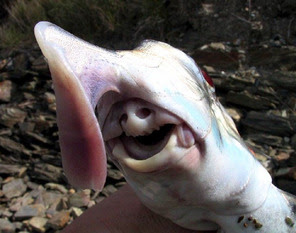Monday, September 10, 2012
Living fossils: elephant shark sees color
CONTINUE
Elephant shark Callorhinchus milii is so called not because of his height but because of the stub nose, which somewhat resembles a bent trunk and probably perform a sensory function in search of prey on the bottom. This is a cartilaginous fish mate with other sharks and rays. They have it one of the most ancient creatures that have passed the test of changing conditions 450 million years ago now. Also known as "ghost Australian Shark" ancient fish has recently become known as the oldest species that have color vision similar to human writes "New Scientist", highlighting the survey results of David Hunt "University College" in London.
Elephant shark as a whole is silver-gray with brown spots on the back and fins. He lives in South Australia and end Kaypara Harbor in New Zealand. Fish is a impressive size - 60 to 120 cm - and is not dangerous to humans. He lives very deep - 200 to 500 meters, and lays its eggs in a shallow water about 40 meters deep. Elephant shark is subject to industrial fishing and its white fillets are consumed in many fish restaurants and eateries of New Zealand. Recently it was found that the genome of prehistoric fish can serve as a "model" for cartilaginous fish genome for many compact size. It is long only 910 megabazi (1 MB = 1,000,000 base pairs), while in humans, for example, the length of the genome is 3000 megabazi. Elephant sharks have color vision, which is considered to be more developed in prehistoric forms. So far it was assumed that the oldest types of color vision (possessing eye photoreceptors type "sticks" for vision in low-light and a "cone" - a bright light) are some sharks coming 374 million years ago. Elephant shark is a new record, because its origin is traced back to 450 million years ago. The discovery was made by the team of David Hunt, who found that fish than "sticks" in his eye and a receptor gene for type "cones" which allows trihromno vision (perceived three primary colors - red, blue and yellow) whatever we do, people.
Subscribe to:
Post Comments (Atom)





No comments:
Post a Comment